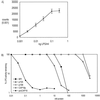Host defense functions of proteolytically processed and parent (unprocessed) cathelicidins of rabbit granulocytes
- PMID: 11796584
- PMCID: PMC127701
- DOI: 10.1128/IAI.70.2.569-576.2002
Host defense functions of proteolytically processed and parent (unprocessed) cathelicidins of rabbit granulocytes
Abstract
Members of the cathelicidin family are present in all mammals studied. Generally, these proteins contain a conserved N-terminal domain and a structurally and functionally divergent C-terminal region that expresses antibacterial or other activities when proteolytically released. Rabbit granulocytes produce CAP18, a cathelicidin that conforms to this structural and functional organization, and also 15-kDa protein isoforms (p15s) that share several key structural features with other cathelicidins but apparently do not undergo processing with release of an active peptide. To further define the importance of proteolysis in the antibacterial activities of these proteins, we have purified from granulocytes proCAP18, its C-terminal peptide (CAP18p), and two p15 isoforms to apparent homogeneity. Of these four polypeptides, only CAP18p was independently cytotoxic to encapsulated Escherichia coli (90% inhibitory concentration, approximately 600 nM) but it was approximately 50-fold less potent on a molar basis than the bactericidal/permeability-increasing protein (BPI). However, all four cathelicidin species, notably including proCAP18, exhibited antibacterial synergy with BPI, and the p15s also displayed synergy with CAP18p in the absence of BPI. Subnanomolar concentrations of proCAP18 blocked lipopolysaccharide-induced chemiluminescence of human leukocytes, showing a molar potency more than 100-fold greater than that of CAP18p ( approximately 20 nM) or BPI ( approximately 50 nM). Thus, while independent bactericidal activity of cathelicidins requires processing, other host-defense functions do not and are more potently expressed by the unprocessed protein than by the C-terminal peptide.
Figures





References
-
- Cross, A. S., P. Gemski, J. C. Sadoff, F. Orskov, and I. Orskov. 1984. The importance of the K1 capsule in invasive infections caused by Escherichia coli. J. Infect. Dis. 149:184-193. - PubMed
-
- Elsbach, P. 1990. Antibiotics from within: antibacterials from human and animal sources. Trends Biotechnol. 8:26-30. - PubMed
-
- Elsbach, P., J. Weiss, R. C. Franson, S. Beckerdite-Quagliata, A. Schneider, and L. Harris. 1979. Separation and purification of a potent bactericidal/permeability-increasing protein and a closely associated phospholipase A2 from rabbit polymorphonuclear leukocytes. Observations on their relationship. J. Biol. Chem. 254:11000-11009. - PubMed
-
- Elsbach, P., J. Weiss, and O. Levy. 1999. Oxygen-independent antimicrobial systems of phagocytes, p. 801-817. In J. I. Gallin and R. Snyderman (ed.), Inflammation: basic principles and clinical correlates, 3rd ed. Lippincott, Williams & Wilkins, Philadelphia, Pa.
Publication types
MeSH terms
Substances
Grants and funding
LinkOut - more resources
Full Text Sources

